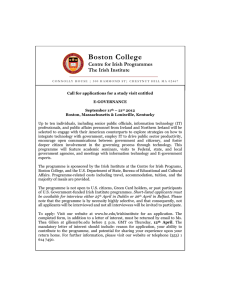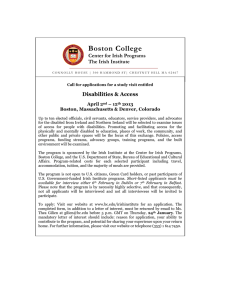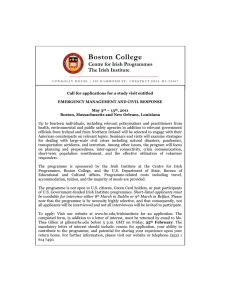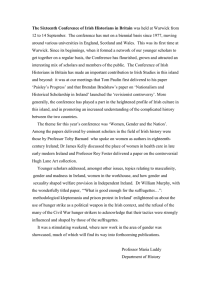Teaching Ireland In The Curriculum
advertisement
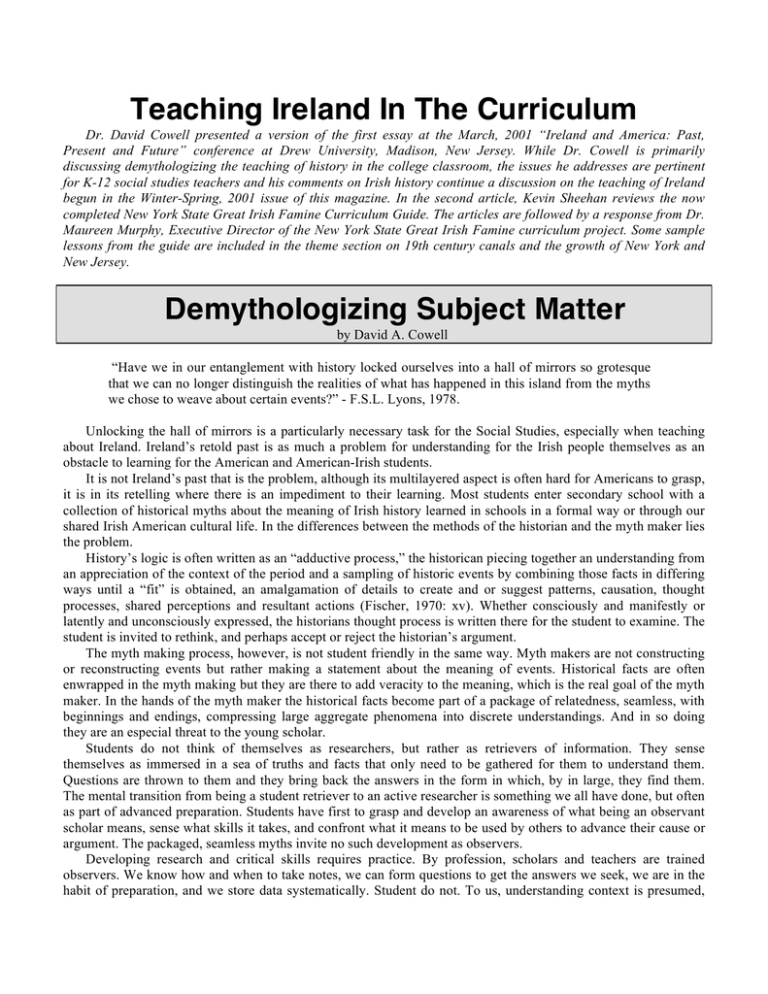
Teaching Ireland In The Curriculum Dr. David Cowell presented a version of the first essay at the March, 2001 “Ireland and America: Past, Present and Future” conference at Drew University, Madison, New Jersey. While Dr. Cowell is primarily discussing demythologizing the teaching of history in the college classroom, the issues he addresses are pertinent for K-12 social studies teachers and his comments on Irish history continue a discussion on the teaching of Ireland begun in the Winter-Spring, 2001 issue of this magazine. In the second article, Kevin Sheehan reviews the now completed New York State Great Irish Famine Curriculum Guide. The articles are followed by a response from Dr. Maureen Murphy, Executive Director of the New York State Great Irish Famine curriculum project. Some sample lessons from the guide are included in the theme section on 19th century canals and the growth of New York and New Jersey. Demythologizing Subject Matter by David A. Cowell “Have we in our entanglement with history locked ourselves into a hall of mirrors so grotesque that we can no longer distinguish the realities of what has happened in this island from the myths we chose to weave about certain events?” - F.S.L. Lyons, 1978. Unlocking the hall of mirrors is a particularly necessary task for the Social Studies, especially when teaching about Ireland. Ireland’s retold past is as much a problem for understanding for the Irish people themselves as an obstacle to learning for the American and American-Irish students. It is not Ireland’s past that is the problem, although its multilayered aspect is often hard for Americans to grasp, it is in its retelling where there is an impediment to their learning. Most students enter secondary school with a collection of historical myths about the meaning of Irish history learned in schools in a formal way or through our shared Irish American cultural life. In the differences between the methods of the historian and the myth maker lies the problem. History’s logic is often written as an “adductive process,” the historican piecing together an understanding from an appreciation of the context of the period and a sampling of historic events by combining those facts in differing ways until a “fit” is obtained, an amalgamation of details to create and or suggest patterns, causation, thought processes, shared perceptions and resultant actions (Fischer, 1970: xv). Whether consciously and manifestly or latently and unconsciously expressed, the historians thought process is written there for the student to examine. The student is invited to rethink, and perhaps accept or reject the historian’s argument. The myth making process, however, is not student friendly in the same way. Myth makers are not constructing or reconstructing events but rather making a statement about the meaning of events. Historical facts are often enwrapped in the myth making but they are there to add veracity to the meaning, which is the real goal of the myth maker. In the hands of the myth maker the historical facts become part of a package of relatedness, seamless, with beginnings and endings, compressing large aggregate phenomena into discrete understandings. And in so doing they are an especial threat to the young scholar. Students do not think of themselves as researchers, but rather as retrievers of information. They sense themselves as immersed in a sea of truths and facts that only need to be gathered for them to understand them. Questions are thrown to them and they bring back the answers in the form in which, by in large, they find them. The mental transition from being a student retriever to an active researcher is something we all have done, but often as part of advanced preparation. Students have first to grasp and develop an awareness of what being an observant scholar means, sense what skills it takes, and confront what it means to be used by others to advance their cause or argument. The packaged, seamless myths invite no such development as observers. Developing research and critical skills requires practice. By profession, scholars and teachers are trained observers. We know how and when to take notes, we can form questions to get the answers we seek, we are in the habit of preparation, and we store data systematically. Student do not. To us, understanding context is presumed, the relatedness of the parts to the whole and to each others is sought, and focusing our thoughts is an obsession. To students, it is all new and sometimes overwhelming. But a myth is a prepackaged whole. It gives no clues about when to take notes, to form questions, what questions do continue to exist, that questioning and uncertainty are part of the process, and what data should be stored and under what categories. The meaning is already clear, preformed and presented without doubts or equivocations. Students also do not understand the complete intellectual process. To them, being a researcher involves a number of discrete tasks to be done when prompted; they rarely understand the whole process altogether - ideas to design to preparation to experience, to reporting and recording, to organization and writing, to submission and defense. Students see their retrieved facts as completed objects, not as tools to be used in a thought process, a thought process designed to advance our understandings. When the answer is simple, known and accepted, what more is there to be researched, learned or thought about? But learn they must, and to do that the teacher must of necessity become a myth buster. Now correcting other people’s work is not always fun, but destroying other people’s myths is downright dangerous, even if well intended. The holders of myths like their myths; they work for their holders. But myths do not work for training critical thinkers. The Great Hunger in Ireland Let us take a look at a great Irish myth - the Great Hunger of the Famine - as an example of a learning opportunity. As the students have often learned, the Great Hunger began with the potato blight in 1845 and ended in 1851 with the death of 800,000 to 1 million Irish and the expulsion and flight of an additional million Irish people, all accompanied by a callous disregard and administrative failure on the part of the English government (and people). A humiliating event the Irish should never remember and the English should never forget. Now without in any way disputing the numbers or minimizing the tragic and horrible deaths, losses, and sufferings, or in any way justifying English behaviors, let us examine the myth as a student would receive it. First, the student would learn that the Great Hunger has a beginning - 1845, the potato blight - and an end - 1851, death and emigration. The Great Hunger was an event, a fact complete in time and space. A horrible fact. Affecting innocent people. Something that happened once in history, was real, true and tragic. However, before the Great Hunger there was what? And after it, no hunger? No dying? The inference is clear: only English callousness and administrative failure. Is it not? And if English callousness and administrative failure followed, did they not also precede? Actually there were three outbreaks of the potato blight, 1845-46, 1848-49, and 1849-50, and each was met by different governmental responses. Each policy response attempted to deal with human suffering. First by food replacement, purchasing and selling grains from abroad and in Ireland; second by direct feeding in emergency arrangements, the soup kitchens, and public works projects; and third by direct feeding, food replacement, work houses and the changing of patterns of rural land holding. These points, often offered as correctives to the historical details of the myth do not change for the student the seamless unity of the myth. What the student needs to know about the Great Hunger is not that there are a lot of details and some dispute about some of the facts but that the Great Hunger was not an event, but a series of events, that in human affairs sometimes the whole of an experience can be greater than the sum of its parts, that events occur in a context which, unlike their laboratory experiments, have no beginning and no end, that the context or environment shapes the events and is shaped by the events, and, finally, that there are larger or at least other lessons to be learned from these events. The myth suggests none of these possibilities. Nor does the myth invite them to think about what they can learn other than its meaning and that the meaning is a fact. Let us sample some of the context of the Great Hunger to demonstrate this point. In 1841 the Irish population numbered 8,175,000, a multitude that doubled the population of 60 years before (4,019,000 in 1785), and had grown by a third in the one generation since 1821. This rapid population growth was achieved without the health benefits of the Industrial and Agricultural revolutions which encouraged population growth in Europe at the same time - no improved sanitation, fresh water, inexpensive clothing, better and cheaper food, and life saving and infant saving vaccinations. By 1824 British authorities were already acknowledging that one third of the Irish population were paupers and English cities were swamped with Irish immigrants seeking a living, working at such low wages that British workers were demonstrating against the loss of jobs and lowering wages. By the beginning of the 19th century the average Irishman was consuming between 8-10 pounds of potatoes daily, often half cooked to take longer to digest. He seldom ate bread, eggs or meat but instead sold his grain, pigs and eggs for cash. Selfsufficiency in rural agriculture was the widespread basis of the social organization, not agricultural laboring for products to sell to the Irish and overseas markets. Farm innovations such as crop rotation kept grain and potato yields as high as the rest of Europe as all available and marginal land was brought under cultivation, often by subdivision of larger holdings, replacing cash crops with rental incomes. Productivity per capita was, however, declining and with it so were rural wages. Abundant and cheap rural labor was turning over Irish fields with spades rather than encouraging the investment in plows, drills, harrows and farm technology as was happening elsewhere. Decompressing the Myth As we decompress the myth, we are opening for the student a world of intellectual and research possibilities. Why was the Irish population growing in spite of the high death rate? Had such rates been achieved under those conditions elsewhere? What was pauperism? How is pauperism measured? Who was counting and why? At what rate were the Irish emigrating before the famine? What impact did existing Irish emigrant communities have on the destination of famine Irish? Was there a pull as well as a push, an attraction as well as a necessity? Were the same sub-groups in Ireland emigrating at the same rate and to the same places? Were there sub-groups? What was the role of British policy in all this? The point here is not to answer these questions. The point here is to indicate that such questions are possible and that their answers would help our understanding of the famine, broaden and deepen it, and that students today can contribute by their research and thought to all of our understandings of the Great Hunger. For another example, examine the myth’s most enduring and central lesson - the callous disregard and administrative failure of the British government and people alike. A theme thought later to be essential to Irish national identity. The course of British policy and the views of British policy makers during the famine are well documented except, I might suggest, in their Irish dimension. The myth suggests, nay even identifies as the essential meaning, that British policy was a product of British effort. The British parliament, of historic fact, included 105 members elected in Ireland and a number of peers in the Lords, people offering their votes and voices to the Britishness of the policies. What were they contributing? To avoid using figures who can be easily dismissed by stereotyping, in this case, by use of terms such as landlords, or squires, or Anglo-Irish or even Ascendancy, let us choose Daniel O’Connell, himself, the Great Liberator. O’Connell was an old man by the time of the Great Hunger, last appearing at Westminster in 1847. He had, however, played, surely, a significant role in shaping British policy in Ireland - supporting the 1830-32 Reform Bill, Catholic Emancipation, the Catholic Relief Act, the Catholic Association movements and agitation, and the creation of the national schools and Queen’s Universities. He also played another role, that of the Great Whig, the first lieutenant of Jeremy Bentham. As a Whig and Utilitarian, O’Connell committed his Irish followers to a laissezfaire, free trade policy and thus attacked the slum and trades workers of Dublin who were attempting to form unions, favored English industrialization and neglected interference in the market mechanisms of Irish agriculture. He led the support for the Corn Laws and opened agricultural free trade within the British Isles putting Irish agriculture in competition with the United States and Canada. His support for the national schools, the nondenominational schools, effectively ended Gaelic speaking and writing (only 10% of the population in 1851 could speak Gaelic and fewer than 1000 could read or write the language). In breaking the power of the Anglican Church of Ireland by ending the “tithe tax” and transferring to the general treasury all the charitable funds entrusted to the Church of Ireland to run the welfare services and relief efforts, O’Connell and his followers championed a real estate tax. When Prime Minister Peel (a Tory) at the recommendation of the Irish Poor Law Commission wanted to reform the Irish poor laws in 1838 replacing them with public works and projects to improve the Irish economy and infrastructure, as well as governmentally financed emigration throughout the Empire, O’Connell led the opposition on the very Whig and laissez-faire grounds that public works would change the markets for labor and cheap labor in Ireland and was an economic advantage for Irish industry (McCaffrey, 1979:53). The purpose of this essay is not to sully the reputation of Daniel O’Connell or lesson his achievements in mobilizing Irish and Irish Catholic political forces. The purpose is to draw attention to the Irish contributions to the laws that shaped British policy in Ireland at the time of the Great Hunger. O’Connell and the Irish Whigs had supported the welfare and pauper policies in place at the time of the Great Hunger, supported the free trade and corn law policies that depressed the prices of Irish agriculture, placed responsibility for relief in the hands of local governments that were dependent upon a single tax source, the land tax, and protected landlord property. Sadly the Irish Whigs joined with the Tories to vote down the Peel administration, which was meeting the first blight with food distribution at subsidized rates, initiating massive private relief efforts through the British Association, and public works projects. The next government was a Whig government, leaving the second and third blights to be met by local work houses and local relief while not interfering with the markets for grain or engaging in market distorting subsidies for food. Moreover, they put the encumbered lands on sale to the free market, beginning the process of communal clearances. The Irish Whig MP’s had all supported all those policies. And now to return to the opening themes - that the Great Hunger had a beginning and an end. By decompressing the myth, we have already shown there was much in the Irish environment before the Great Hunger to threaten the population. Clearly the policies and practices, the agricultural situation and growing population problems began long before the potato blight arrived. Just as clearly the Great Hunger shaped events long after 1851. Ireland’s population never recovered, as it did after the same magnitude famine in 1740-41 (10% of the population died) and as did all the other famine afflicted populations of 1845-46 in France, Germany, Poland, Spain, and England. “What is peculiar, therefore, was not the famine, but the long-term response of Irish society to the short term calamity” (Lee, 1984:1). Irish population would fall steadily until the late 20th century and Irish emigration became an institutionalized social practice, as did late marriages, a changing rural class structure, declining marriage and birth rates, and a static death rate. In a real sense, the famine or Great Hunger is affecting Ireland (and the United States) still, and perhaps will until the myth is finally broken and the famine’s effects and causes are opened to another generation of scholars and researchers. References Fischer, D. (1970). Historians’ Fallacies. Harper and Row. Lee, J. (1984). The Modernization of Irish Society. Dublin: Gill and Macmillan. Lyons, F. (1978). “The Burden of History,” Rankin Lecture. Queens’ University, Belfast, Northern Ireland. McCaffrey, L. (1979). Ireland: From Colony to Nation State. Englewood Cliffs, N.J.; Prentice-Hall, Inc




